-
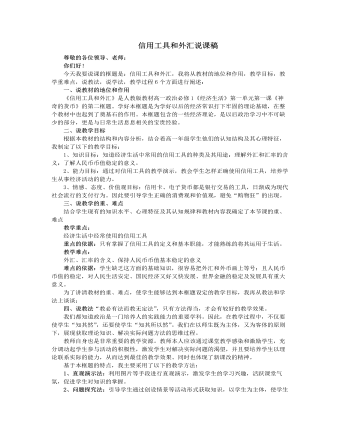
人教版高中政治必修1信用工具和外汇说课稿
一、对教材内容的处理根据新课程标准的要求、知识的跨度、学生的认知水平,我对教材内容有增有减。二、教学策略的选用(一)运用了模拟活动,强化学生的生活体验,本框题知识所对应的经济现象,学生已具有了一定的生活体验,但是缺乏对这种体验的深入思考。因此在进一步强化这种体验的过程中进行了思考和认知,使知识从学生的生活体验中来,从学生的思考探究中来,有助于提高学生的兴趣,有助于充分调动学生现有的知识,培养学生的各种能力,也有助于实现理论知识与实际生活的交融。(二)组织学生探究知识并形成新的知识我从学生的生活体验入手,运用案例等形式创设情境呈现问题,使学生在自主探索、合作交流的过程中,发现问题、分析问题、解决问题,在问题的分析与解决中主动构建知识。也正是由于这些认识来自于学生自身的体验,因此学生不仅“懂”了,而且“信”了。从内心上认同这些观点,进而能够主动地内化为自己的情感、态度、价值观,并融入到实践活动中去,有助于实现知、行、信的统一。
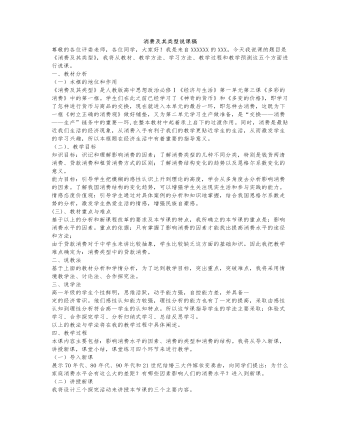
人教版高中政治必修1消费及其类型说课稿
(三)课堂小结接着进行课堂小结,先让学生自主总结,教师结合学生的总结,补充完善总结本节课的知识。并进行感情升华。这样设计课堂小结,是为了让学生学会自主总结知识,加深印象,教师总结帮助学生理清本课知识结构,并起到升华本节课的感情基调,落实教学目标。(四)课堂练习我将设计两道题让同学们做,巩固课堂知识。本课题板书设计我主要采用大纲的形式展现,让学生一目了然,便于识记和理解主干知识。五、教学预测最后我对本节课教学的效果进行预测:在这个教学过程中我都是从学生生活中感知的现象入手,设计情境,预设学生的分析,学生的体验,学生的感知,教师的点拨等。设计问题,学生自主合作探究,完成教学!通过这样的学习我想一定会收到较好的教学效果,当然,在实际的教学中,肯定也会出现一些意想不到的情况,我还会根据教学过程中的动态变化,及时地调整和修改预设内容。
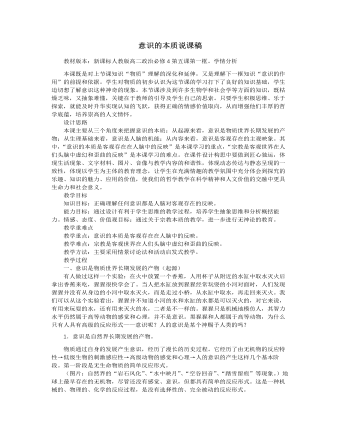
人教版高中政治必修4意识的本质说课稿
师:分析得非常到位。大家来看看薛宝钗是怎么说的?薛宝钗的评论:“不像吟月了,月字底下放一个‘色’字倒还使得,你看句句倒是月色。这也罢了,原来诗从胡说来,再迟几天就好了。”生:(读第三首诗)“精华欲掩料应难,影自娟娟魄自寒。一片砧敲千里白,半轮鸡唱五更残。绿蓑江上秋闻笛,红袖楼头夜倚栏。博得嫦娥应借问,缘何不使永团圆!”这首诗语言很朴实,但意境很深远。我虽然读过《红楼梦》这本书,也看过电视剧,但我阅历太浅,说不出诗中所包含的深刻内涵。师:贾宝玉的评论:“这首不但好,而且新巧有意趣,可知俗语说的‘天下无难事,只怕有心人。2.意识的形式是主观的意识是人脑对客观存在的反映,意识是不是仅仅是人脑对客观存在原原本本的反映呢?“龙、凤”是中华民族的象征,是炎黄子孙的两大主要图腾,但地球上从来就没有出现过“龙、凤”,那么“龙、凤”的观念又是从何而来的呢?原来,“龙、凤”的观念最早产生于原始社会的图腾崇拜。、
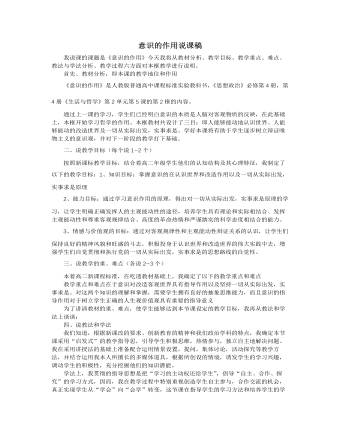
人教版高中政治必修4意识的作用说课稿(一)
1、课题引入:我设计以提问哲学到底是什么?的问题激发学生的阅读兴趣。我设计典型事例,通过学生讨论,教师总结的形式,并得出其实哲学就在我们身边。2、讲授新课:(35分钟)通过教材第一目的讲解,让学生明白,生活和学习中有许多蕴涵哲学道理的故事,表明哲学并不神秘总结并过渡:生活也离不开哲学,哲学可以是我正确看待自然、人生、和社会的发展,从而指导人们正确的认识和改造世界。整个过程将伴随着多媒体影像资料和生生对话讨论以提高学生的积极性。3、课堂反馈,知识迁移。最后对本科课进行小结,巩固重点难点,将本课的哲学知识迁移到与生活相关的例子,实现对知识的升华以及学生的再次创新;可使学生更深刻地理解重点和难点,为下一框学习做好准备。

人教版高中英语必修1Journey Down the Mekong说课稿
2. let the Ss complete the forms paragraph by paragraph. Purpose here is to help Ss to get the habit of reading a passage as a whole, and pay attention to the organization of the text, as a result the Ss will fully understand the whole passage.3. ask Ss to retell the passage with the help of the key words in the form.Since the Ss in the class are in different levels, so I let them to fill in the blank to understand the meaning of the words and phrases better. ( That’s all for the while-reading. Now let’s move to the fifth step.)Step V: Post-reading (10mins) ---DiscussionIn this part students are asked to discuss in groups and list Wang Kun’s and Wang Wei’s attitudes about the trip. After that, Ss are encouraged to express their attitudes with the whole class. Collect their answers and don’t forget to praise them even if their answers may not be perfect.In this activity, discussion provides a vivid and active learning environment for Ss to communicate in English with newly learned language items. (Finally it comes to the homework.)StepⅥ: Homework (1min)1. Ss are required to read the text again after class and figure out the meaning of some complex sentences.2. Do the exercises on P19; This can help Ss to consolidate what they’ve learnt and make preparation for the next lessonPart4. Blackboard design.(说板书设计)On the top, there is the title of this lesson. On the left, there are main ideas for each paragraph. On the right, there are some new words and expressions.Unit 3 Travel journalJourney down the MekongMain idea of each para.:Para1: deciding to take a great bike trip along the Mekong river.Para2: Different attitudes between Wang kun and Wang wei.

人教版高中英语必修3Canada-the true north说课稿4篇
Good afternoon, teachers, It’s my great pleasure to be here sharing my lesson with you.The content of my lesson is Senior English Book 3 Unit 5 Canada —— “The true North”.I’ll be ready to begin this lesson from five parts. Analysis of the teaching material,the teaching methods,the studying methods, the teaching procedure,and Blackboard design.First, let me talk about the teaching material.Part 1 Teaching Material:This unit is about the introduction of Canada. By studying of this unit,we’ll enable the students to learn the geography, population, main cities, and natural beauty, natural resources of Canada. Through the training of the unit, it also requires students to learn some Language skills such as the expressions of position and emotions.So it plays an important part in the English teaching in this book.After studying the teaching material and analyzing the rule of children’s growing of mind,I think the teaching aims are the followings:1.Knowledge objects:(1) make the students learn some new words and phrases(2) make the students understand the content of the lesson.2.Ability objects:(1)To develop the Ss’ abilities of listening, speaking, reading and writing. Especially reading and speaking ability.(2) learn to talk about the characters of Canada in English(3)To train the Ss’ ability of working in pairs.3.Emotion objects:(1)Enable students to understand the characters of Canada..(2)Stimulate Ss to work hard to make China stronger.Part 2 Teaching Methods:I think helping students learn to master new words and phrases and improve the students’ reading and speaking ability is import and the difficult.According to the analysis of the teaching material and the import points and the difficult points,I will use the following teaching methods : question-guiding approach; fast-reading and careful reading; multi-media teaching methods; discussion

人教版高中英语必修4Women of achievement说课稿4篇
Good morning, distinguished judges:It’s my honor to talk about my teaching ideas with you. Today my topic is Women of Achievement. My presentation consists of six parts: the analysis of teaching material and student, teaching aims, key and difficult points, teaching and studying method, teaching procedures and blackboard design.First, let’s focus on the analysis of teaching material. This lesson is from New Senior English for China Student’s Book 4 Unit 1, the reading part. The main topic of the passage is the introduction of a student of Africanwildlife. After this lesson, the students will learn more information about her studying chimps in Africa, and their reading and speaking abilities can be developed as well.The next part is the analysis of students. My students are in senior high students. They have learnt English for many years, they’ve known many words and sentences, but their speaking and reading abilities are still not very good. So I will practice their speaking and reading abilities through different exercises.According to the New Standard Curriculum and the present situation, I set the teaching aims as follows: firstly, knowledge aims. Students can grasp some new words, such as worthwhile, move off. Moreover, students can understand the content of the passage and get familiar with the topic of studying chimps in wildlife. Secondly, ability aims. Students can use reading strategies such as skimming and scanning in reading process. Thirdly, emotional aims. Students can have the awareness of protecting animals and care about animals.Based on the above analysis, the key point of this lesson is to get the main idea and the detailed information from the passage; the difficult point is to talk about the wildlife protection and use reading strategies.

人教版高中英语必修3Festivals around the World说课稿3篇
Teaching plan for Unit 1 book3Good morning, teachers. It’s my great pleasure to be here because I can share my lesson with you and I can learn a lot from it. I’ll begin my lesson from the following four parts, the teaching material, the teaching methods, the studying methods and the teaching procedure.Firstly, let me talk about the teaching material. The content of my lesson is the reading passage festivals and celebrations of Unit 1 Festivals around the world. This passage is about festivals and celebrations. By studying this passage, we’ll enable the students to know that festivals exit everywhere, and many of festivals in different countries celebrate similar ideas. As we all know, the reading passage is the center of each unit. If the Ss can learn it well, it will be helpful to make the Ss learn the rest of this unit.After studying the teaching material, I think the teaching aims are as the followings:1. Knowledge aims:(1) The Ss can master the usage of the important words andexpressions.(2)The Ss can use the __________________ (grammar) in the proper situation.Make students know about the festivals all over the world and the detail of the festivals, such as origin, content, and the date of the holiday festivals.2. Ability aims:(1) Students can talk about festivals and celebrations in English(2) To improve the student’s reading ability, especially their skimming and scanning ability.3. Emotion aims:Make the Ss know about the foreign festivals, and respect other countries’ custom.Next, let’s come to the important points and the difficult points.The important point is how to make the Ss understand the text better and the difficult point is how can they talk about it. secondly, Teaching Methods:1. task-based Language Teaching2. Computer assisted language teaching.3. question-and–answer methodThirdly, Studying Methods:

人教版高中英语必修4Theme parks说课稿3篇
The oldest and the most popular park in the worldenjoy the exciting activities thereget close to the life-size cartoon characters like Mickey Mouse and Donald Duck Step 3 Pre-reading1.What do you suppose a theme park is ?2.What do you think you can see in a theme park?(1.It is a kind of amusement park which has a certain theme – that the whole park is based on. 2.buildings, castles, statues, rare animals and birds, and so on.) Step 4 Reading ----- Theme Parks –---- Fun and More Than Fun1.Predict : Read the title and the pictures on P. 34 and PredictWhat is the meaning of the title “Theme Park – Fun and more than fun”?(The title means that theme parks are fun to visit, but that they can also be educational and can offer useful information.)2.Skimming Fast read and answer:What activities can we take in a theme park?Amusement park: Bumper car Merry-go-round slide bungee jumping Free-fall rides Horror films Pirate ship Ferris wheel roller coaster3.Scanning Read again and you will find various theme parks are mentioned in the passage . Then what are they ?Theme parks: Sports theme park History theme park Culture theme park Marine or Ocean theme Park Future park Science theme park Disneyland4.Careful reading and find the main idea of each paragraph:THEME PARKS---- entertaining/ educationalPara.1 Traditional parks are places to go for relaxation and to have time away from our busy lives.Para.2 Theme parks are different They’re large and full of things to do, see and buy.Para.3 Theme parks are built around a single idea or theme. One example is a sports park.Para.4 Another kind of theme park is historical more and cultural and can be educational.Para.5 Disneylandwas the first theme park. It is based on the fantasy life and characters of Disney’s films.Para.6 Some examples of educational theme parks include sea world parks and science parks.

人教版高中英语必修4Working The Land说课稿3篇
Knowledge objectives:(1) to make Ss grasp the usage of words, expressions and sentence structures: statistics, struggle, thanks to, rid of, some patterns for persuasion, the “ing” form as subject and object;(2)to use learnt knowledge to persuade sb.Ability objectives:(1) to develop Ss’ reading skills(skimming, scanning, word guessing);(2) to improve Ss’ speaking, communicating and cooperating skills.Emotional objectives:to make Ss know the contribution of Yuan,and learn his spirit and his simple life time.Teaching important and difficult points:(1) some words, expressions and sentence structures mentioned above;(2)the content of the text;(3)training their reading and speaking skills.Teaching methods: CLT, TBLT,QT.Learning strategies: CLS, QLS, TBLS.Teaching procedures:Step 1 lead-in: (1) teacher plays a piece of recent news from CCTV about the harvest of the super hybrid rice, and ask students whether they know Yuan or not, and talk about him and his contribution.(2)Brain storm: let Ss describe Yuan in their minds including his appearance, his living condition and so on.Step 2 fast reading tasks:(1)teacher introduces Yuan and super hybrid rice(2)make Ss read the text as fast as possible with questions. Such as: what’s the general ideaof this passage? What’s Yuan’ dream? (skimming and scanning skill)Step 3 intensive reading tasks(1)let Ss read the text silently, find topic sentence of each paragraph and draw the difficult sentences and the knowledge what they don’t understand.(words guessing)(2)teacher and Ss talk about the important words, expressions and sentences together, and ask Ss to retell the content of the text.(summarizing and paraphrasing)(3)teacher summarize this part.(4) read again following the courseware.

人教版高中英语必修5Life in the Future说课稿5篇
Good afternoon, everyone. It’s my great pleasure to be here sharing my lesson with you. The content of my lesson is Senior English for China Book5 Unit 3 Life in the Future. I’ll be ready to begin this lesson from six parts: Analysis of the teaching material, Analysis of the students, Teaching aims and important and difficult points, Teaching methods and aids, Teaching procedures, and Blackboard design. First, let me talk about the teaching material.Part 1 Analysis of the Teaching Material:This unit is about what human beings’ life will be like in about one thousand years. By studying of this unit, we’ll Enable the students to know the changes in humans’ life and some new inventions bringing about the change and develop the interest in science. This lesson plays an important part in the English teaching in this unit. This is an important lesson in Book Five. From this lesson, it starts asking the Ss to grasp contents of each passage. Therefore, this lesson is in the important position of the teaching material. If the Ss can learn it well, it will be helpful to make the Ss learn the rest of this unit.Part 2 Analysis of the SsAs Senior2 Ss, they are at different levels of English fluency, some of them have lost interest in English. So during the lesson, I arrange a variety of activities to let all of them join in to attract their interest and let them be confident and taste the joy of success.

人教版高中英语必修5Making the news说课稿4篇
今天我们来介绍一下必修五第四单元的授课方式。这个单元的题目是Making the news。应该是学生比较感兴趣的话题,学生往往对新闻工作充满好奇,所以我们可以利用这个机会多设计一些师生互动和学生互动,来激发起学习的积极性,提高学习效率。同时我们可以利用这个单元不仅帮助学生掌握语言知识,培养语言能力,同时让其了解新闻工作的重要性,培养起社会智能感。这个单元分为六个课时,它的教学目标是这样的:语言目标是掌握词汇表中的常用单词和短语,掌握倒装句的一些基本用法。 技能目标是能初步掌握约会的基本句型并在真实的场景下正确运用。新闻报道类文章的写作技能。采访的基本规范和沟通技能。情感目标是对新闻报道的客观性和真实性有更好的理解。对新闻记者的职业有更深入的了解,并能体会其工作的重要性。下面我们来介绍一下第一课时的授课方式,第一课的教学目标是这样的第一课时的教学目标语言目标:单词:Occupation, journalist, editor, photographer, curious, personality, enthusiasm

人教版高中英语必修5The United Kingdom说课稿4篇
Teaching Aims:Knowledge 1. Get the students to learn the useful new words and expressions in this section. Aims:2. Let the students learn about how the UK was formed and the four groups of invaders.1. Develop students’ reading ability and let them learn different Ability reading skills. Aims:2. Enable students to learn to talk about the United Kingdom and the Union Jack Emotional 1. Let students know more about the UK2. Develop students’ sense of cooperative learning Aims:Teaching Important Points:1. Let the students learn about the countries of the United Kingdom and the Union Jack2. Get the students to read the passage and know about how the UK was formed and the four groups of invaders.3. Have the students learn different reading skills.Teaching Difficult Ponts:1. Develop students’ reading ability.2. Enable students to talk about the United Kingdom and the Union Jack.3. Let students learn how the UK was formed geographically and historically.Teaching Methods:Showing pictures, asking, exercising, listening, reading etc.Teaching Aids:A computer,a projector and a blackboard.Teaching Procedures: 1) Show a map of the world, ask students the following questions:Where is the UK?What’s the full name of the UK?2) Ask the students work in pairs to do the quiz on Page 9.Do you want to test how many things you know about the United Kingdom? Let’s have a small test.Using the map on P9, students answer the following questions:?How many countries does the UK consist of? What are they??England is divided into three main areas. Do you know what they are? 1) Scanning (10Minutes )Let the students hold the questions asked in pre-reading and read the passagequickly and then let them do the following exercise.Join lines to the right answer.
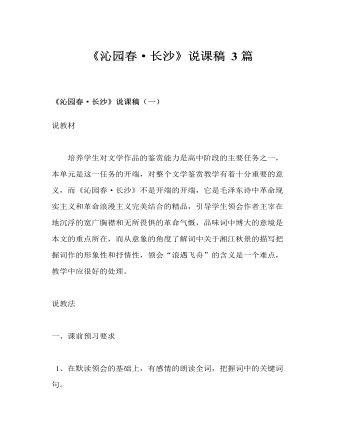
人教版高中语文必修1《沁园春·长沙》说课稿3篇
4、学习全词:(1)背景介绍,让学生看课文中的年代,然后让学生回忆1925年的毛泽东的情况,老师适当提示,让学生了解其背景。(出示幻灯片)(2)学生自由朗读,结合注释和背景理解诗词。(3)师生共同理解全词①先让学生齐读前三句,思考正确的语序,并用正常的语序解释。②品味第三到第十句,这里是教学的一个重点,要让学生先读,再理解,在此基础上训练学生的想象能力。③分析上阙中的最后三句。④小结上阙。提出了一个问题“谁主沉浮”让学生在文中找内容回答,然后转入下阙内容的分析。⑤分析下阙内容,回答“谁主沉浮”的问题,突出本文主旨5、描绘诗词形象:学生用自己的语言把上阙的内容生动地描绘出来。6、欣赏学生优秀作品。(根据时间具体而定,也可以作为课后作业)
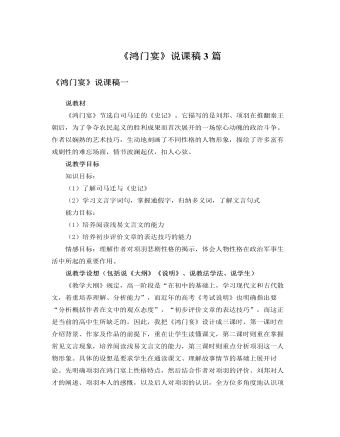
人教版高中语文必修1《鸿门宴》说课稿3篇
3、拓展延伸,启迪心智,创设课堂训练营。三、说学法1、纸上得来终觉浅,圈点、勾画、批注法,学好文言基本功。2、自主合作加探究,眼耳口脑手并用,破疑解难在其中。四、说课时安排《鸿门宴》篇幅较长,文言知识较丰富,文章内涵丰厚,因此我设计用五课时教学本文。第一课时:了解作家作品,积累文言知识,感受作者隐忍发愤的著书精神(初读)第二课时:理清故事情节,概括人物形象,学习客观地评论历史人物,(熟读)第三课时:进一步梳理文言知识,精读课文,要求读透。(精读)第四课时:通过对人物、事件的赏析,加深学生对人物的理解,锻炼学生的开放性思维,由学生自主认识到人物的性格,悲剧的原因等问题。(赏读)第五课时:补充课本教学内容:同学生一起阅读古今关于刘邦项羽的一些篇章:让学生投入进来,把握自己眼中的项羽。(展读)在文言文学习的过程中,采取五步学习法:初读-熟读-精读-赏读-展读(板书)

人教版高中语文必修1《论语》说课稿
三、文本中的句子解决完毕,大家对文本内容的理解更加深入了。请速度文本,思考:《论语》具体涉及了哪些方面的内容,体现了孔子什么观点?明确:主要有治学、从政、修身养性和交友治道等方面,体现了孔子“克己复礼”的思想。四、 教师引导学生讨论: 如何评价孔子的言行和观点?从古至今人们对孔子有哪些评价?明确:1、春秋战国时代, 孔子门人及其后学者均推尊孔子。门人中以子贡为代表,他对孔子赞美备至,奉如天人,把孔子比拟为高天、日月、木铎,凡人是永远不可企及的,认为孔子是天生的圣人,“仰之弥高,钻之弥坚”。亚圣孟子认为孔子所行的“圣人之道”是遍及自然界和社会的至高准则。然而当时民间一般看法认为孔子是博学成名的大学者。
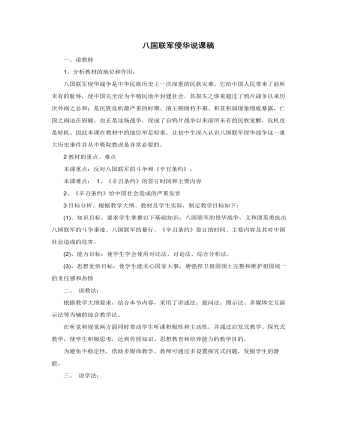
人教版高中历史必修1八国联军侵华说课稿
4,教师重点点拨以下几个问题⑴廊坊战役:义和团浴血奋战,对敌人毫不退缩, 其胜利,挫败了西摩尔联军进犯北京的计划,沉重打击了侵略者的气焰,粉碎了所谓“西方军队无敌”的神话。这是对学生进行爱国主义的重要素材之一,教师重点点拨突出其情感教育的重要作用。⑵让学生(阅读教材小字和材料,结合插图,认清八国联军对中国人民犯下的滔天罪行。)并让学生分组探讨自己的看法,一方面培养学生的语言表诉能力,另一方面通过学生的诉说激发学生的爱国情感,树立落后就要挨打的观念.⑶指导学生通过对条约主要内容进行了分析,并自然得出结论:清政府完全成为帝国主义统治中国的工具,中国完全陷入半殖民地半封建社会。让学生逐步学会分析和归纳能力(4)进行拓展训练出示中国近代史上列强的大规模的侵华战争和中国人民的反抗斗争

人教版高中历史必修3启蒙运动说课稿
教材地位本课具有承上启下的作用,前承文艺复兴,后启资产阶级革命时代的到来,启蒙运动为资本主义社会构建了一套政治蓝图,具有前瞻性,是近代第二次思想解放运动。因此,本节内容在整个教材中有着很重要的地位。教学目标1、知识目标:(1)帮助学生了解启蒙运动的性质、内容和主要启蒙 思想家及其主张。(2)理解启蒙运动兴起的背景、影响。2、能力目标:(1)在讨论和探究过程中训练学生的科学思维方法和自主学习的能力和掌握解题的方法。(2)通过指导学生阅读启蒙思想家的言论资料,培养学生对历史资料的理解和归纳能力。3、情感价值目标:(1)培养人文意识,强化法治观念。(2)培养学生的团结协作精神和竞争意识。教学重点、难点(1)教学重点:启蒙思想家的主张及启蒙运动的影响。
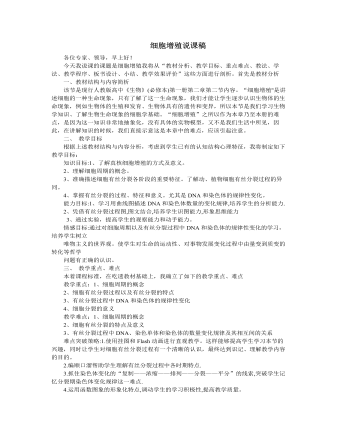
人教版高中生物必修1细胞增殖说课稿
f.有丝分裂的意义(讨论分析教学),首先引导学生结合所学知识讨论有丝分裂的的作用,最后有教师归纳总结,并要求学生在理解的基础上记忆。g.无丝分裂(图形直观教学、简介),本部分内容不是教学的重点,内容也相对简单,所以我的教学方法是直接给学生展示挂图,再进行简短介绍,让学生了解即可。h.引出减数分裂的概念,为第五章学习打下基础。小结:新课讲完以后由教师对本节内容进行总结巩固和反馈:进行一些课堂练习达到巩固和反馈的作用。最后布置作业,各种难度的作业题目均设置一些,其中简单题比重大,难题要求学生选作,这样提高学生学习积极性。2教学媒体程序设计: 细胞周期的概念(多媒体课件演示周期动画)植物细胞有丝分裂(多媒体课件演示分裂各期动画)动植物细胞有丝分裂异同点(多媒体课件演示分裂各期动画)有丝分裂过程中DNA和染色体数量的变化规律(挂图演示,包括表格和函数图象)
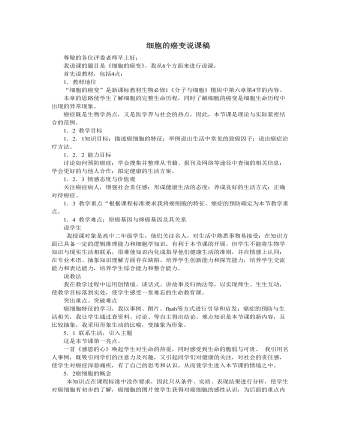
人教版高中生物必修1细胞的癌变说课稿
5.5癌症的预防作为本节最重要内容,且与生活息息相关,我采用老师引导、学生讨论总结的方法进行教学。从生活各方面总结出保健良方 ,既对知识有很好应用,又体现对生命的热爱。此时,本节课达到高潮,同学们意气风发,热烈讨论,实现本节课的教学目标。5.6 癌症的治疗通过讲述癌症治疗方法的副作用,激发学生探究生物学欲望,激励学生立志除癌。 在此,我选用一则关于一名癌症晚期病人运用心理疗法成功战胜癌症的故事,在于对不同层次的学生进行多方面启发教育,体现面向全体学生的课程理念。5.7 愉悦总结,及时反馈本节知识点零散,我将带领学生回忆浏览本节内容,使零散知识点系统化。在课堂反馈环节,我通过简单练习采用分组竞答的方式把握学生对知识的掌握程度,并给予表现突出的学生适当奖励,这是本节课第三个亮点。竞答既使课堂显得紧凑、集中,又有利于形成学生的竞争意识,还使得学生的知识得以巩固应用。